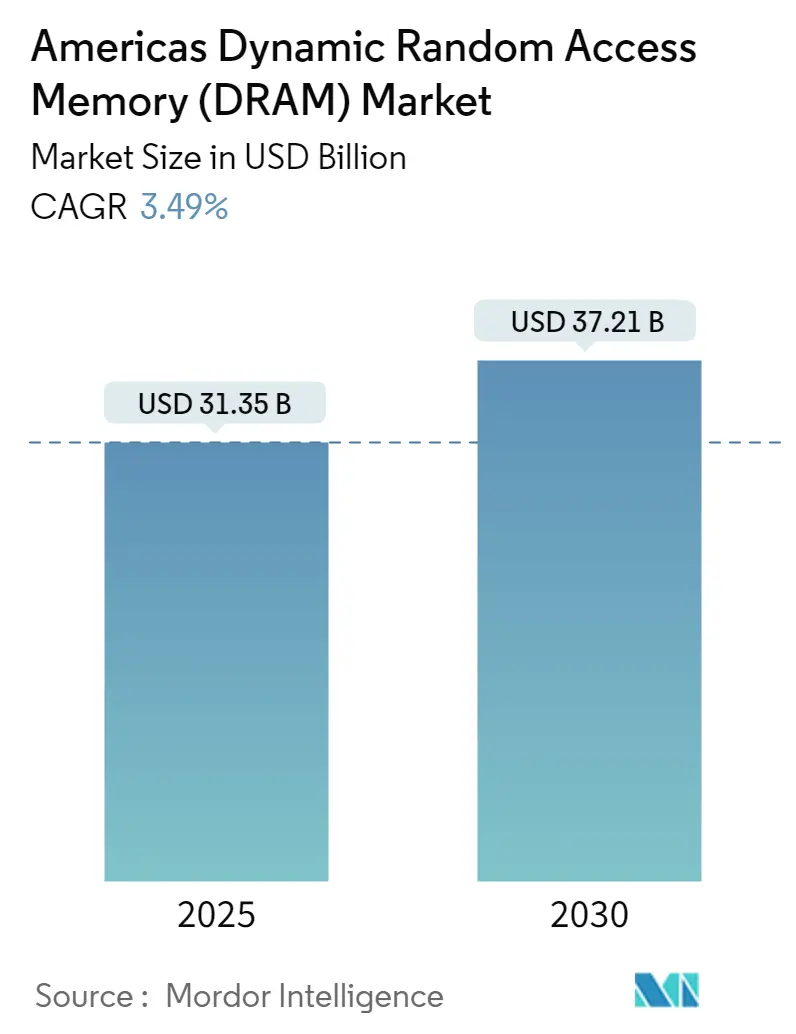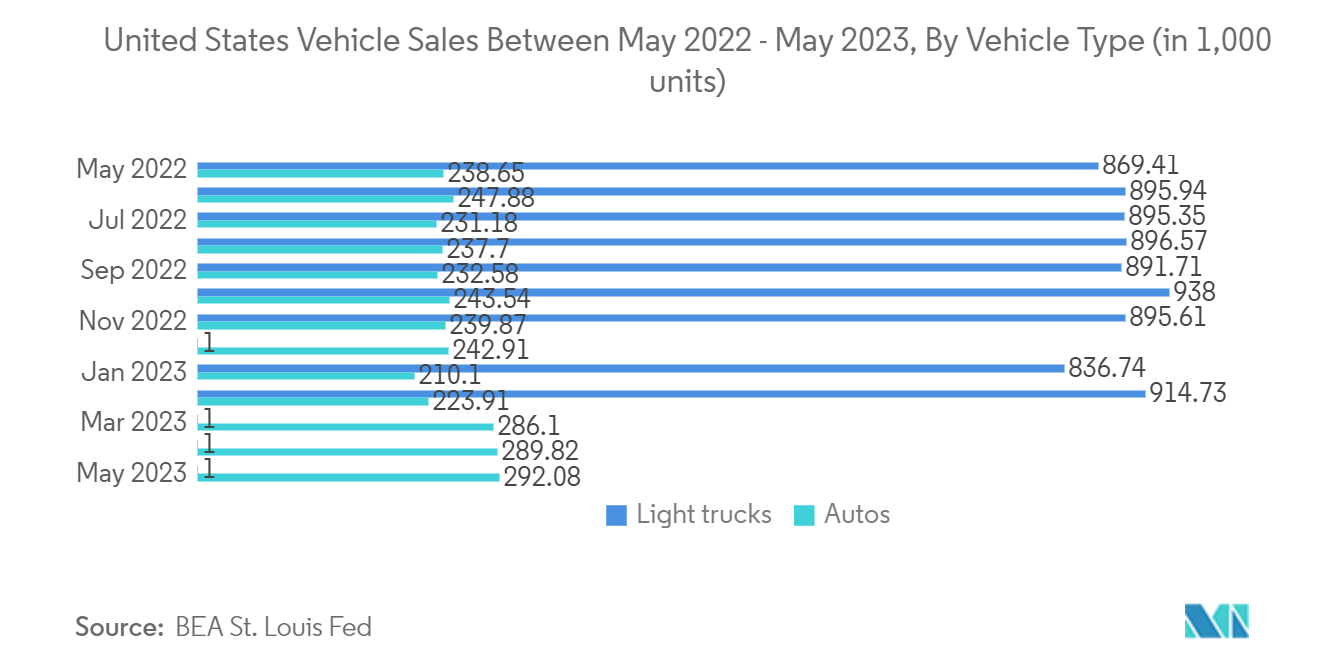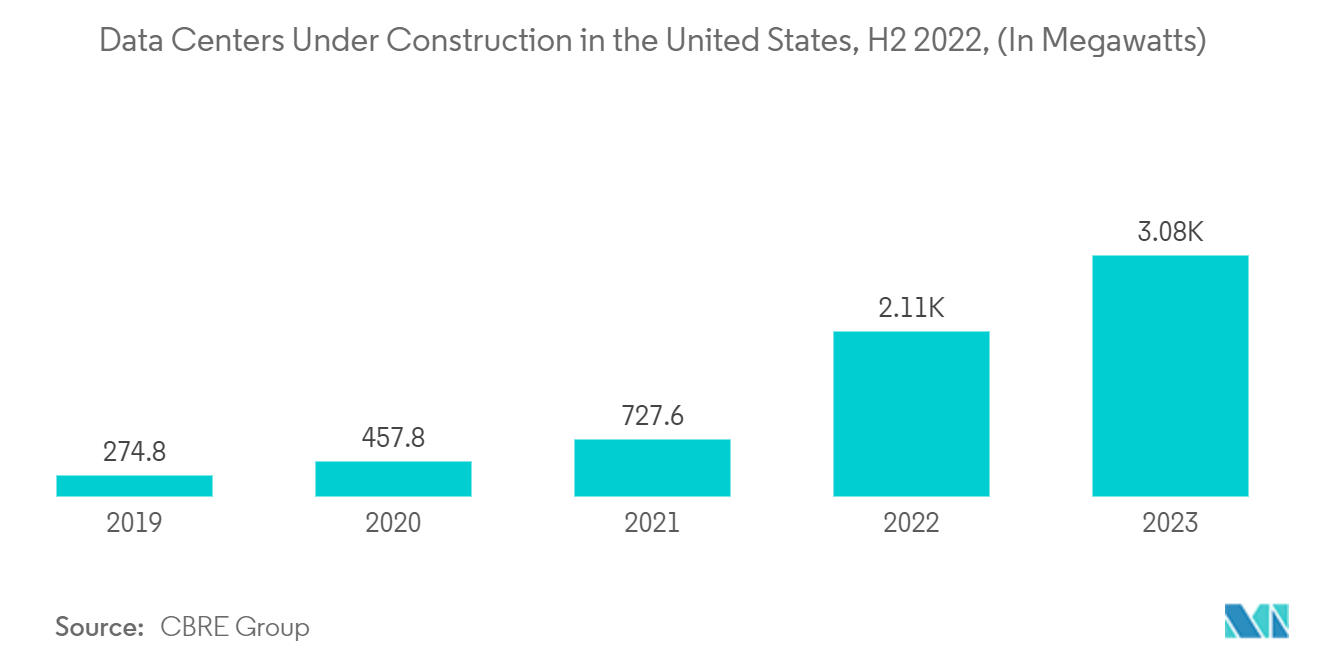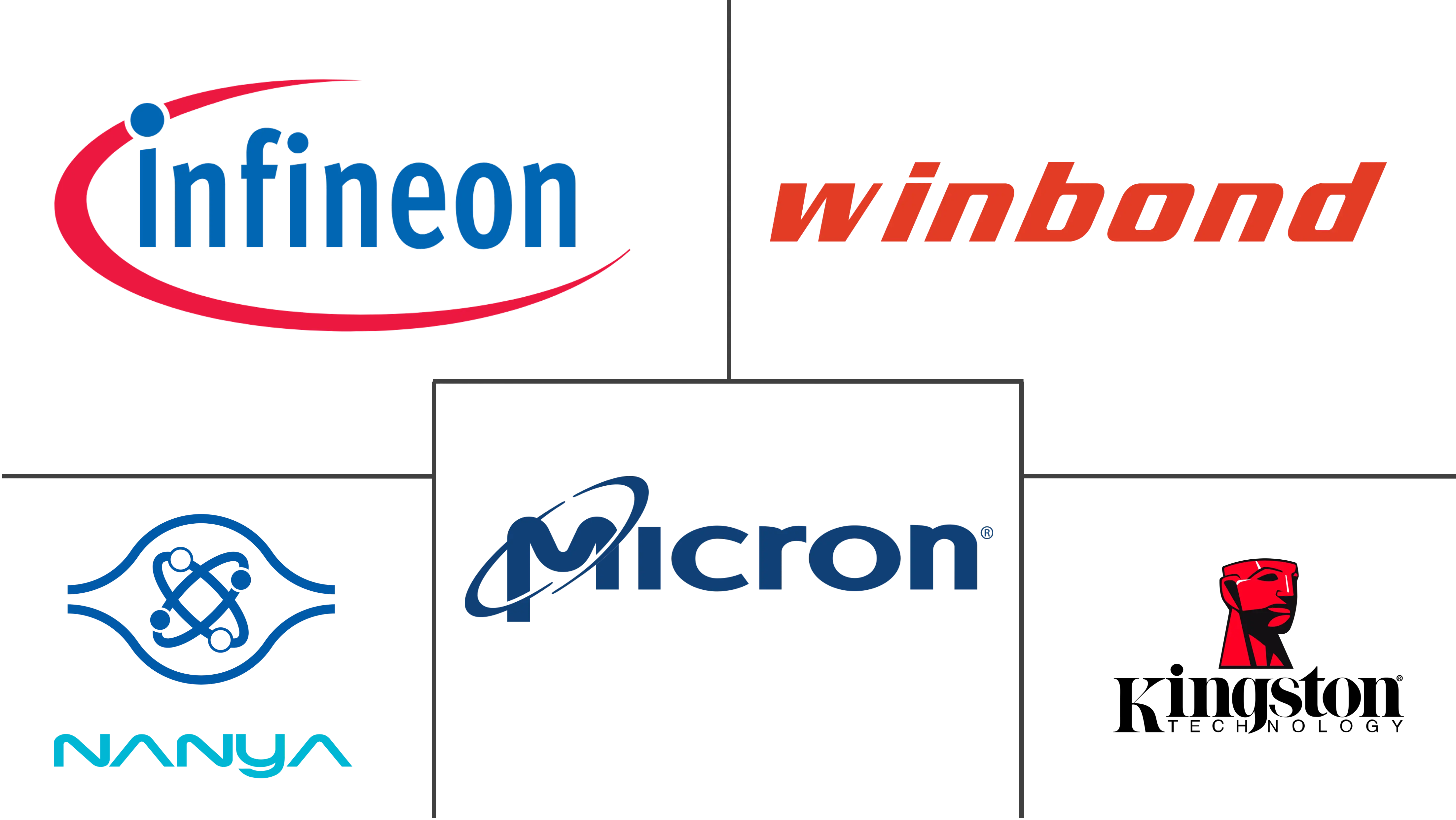
Americas Dynamic Random Access Memory (DRAM) Market Analysis
The Americas Dynamic Random Access Memory Market size is estimated at USD 31.35 billion in 2025, and is expected to reach USD 37.21 billion by 2030, at a CAGR of 3.49% during the forecast period (2025-2030).
The Americas is expected to witness considerable growth in the DRAM market over the forecast period, primarily due to high technological advancements in the region.
- One of the main drivers of the DRAM market is the surge in demand for high-memory mobile devices like smartphones and tablets for high performance. Due to their increasing market penetration and falling prices, mobile phones are anticipated to hold a sizable portion of the DRAM market. Additionally, the demand for high-performance and low-power DRAM solutions in mobile devices is anticipated to spur expansion in the Americas' DRAM market.
- The increasing number of data centers, growing reliance on AI, machine learning, big data, IoT, industrial and consumer electronics, and ICT infrastructure are some of the factors propelling the production of DRAM. Some of the short-term DRAM demand drivers include increasing demand for gaming and educational notebooks, ongoing low- and mid-priced 5G smartphone launches, rising GPU demand due to the rising cryptocurrency mining, significant gaming console demand, and significant home entertainment demand for TVs, smart speakers, and set-top boxes because of the rising disposable income in American countries.
- The market's growth can be primarily attributed to the region's increased demand for smartphones and personal laptops, supporting the region's increased production of DRAM chips. One of the primary factors driving the demand for personal computers in the region is an increase in the number of adults in the United States who engage in online gaming.
- However, the ever-increasing price sensitivity of the features on these electronic devices is another factor contributing to the decline in demand for electronics. DRAM demand is expected to decrease in the market. Additionally, DRAM provides one-time investments for memory solutions because, barring significant damage, it has a long lifespan. However, DRAM manufacturing demand will consequently decrease, making it more difficult for market suppliers to compete.
Americas Dynamic Random Access Memory (DRAM) Market Trends
Automotive is Expected to Register Significant Growth
- The rapidly expanding automotive industry in the region is expected to propel the region's DRAM market size. The increasing demand for ADAS and self-driving vehicle systems in the United States, Canada, and Brazil is likely to increase DRAM production in the region.
- The region's fastest-growing application sector is ADAS, attributed to the rise in traffic accidents, which led to stricter safety regulations and increased demand for ADAS in the American market. The market demand for onboard storage and data processing is increasing with the introduction of next-generation instrument clusters that show detailed graphical gauge readouts on substantial, high-resolution color displays.
- These systems also need cutting-edge processors with large memory capacities and bandwidths. New rules are also anticipated to be implemented by the US government to safeguard the safety of drivers and passengers and stop common mistakes in automotive systems.
- In June 2022, Micron announced the expansion of its ecosystem and embedded product line that addresses data at the edge in the automotive markets. Micron declared that its LPDDR5 DRAM had received the first ISO 26262 Automotive Safety Integration Level (ASIL) D certification for memory. Similarly, the automotive industry is developing quickly due to the first LPDDR5 ISO 26262 ASIL D certification in the world.

United States May Dominate the Market During the Forecast Period
- In the United States, DRAM chip reliance is almost entirely placed on South Korea, which maintains roughly half the production capacity for DRAM chips worldwide. Further, China and Taiwan account for nearly half of global manufacturing. The nation requires faster-changing technologies, more effective processing systems, and high data generation across industries. Non-volatile, dense, and energy-efficient memories have become a top priority with the rise of mobile and low-power devices, high-end data centers, and large on-chip caches.
- According to Cloudscene, there were about 2,751 data centers in the United States in 2022. The data center is now the primary computing structure. Modern, secure accelerated data centers must have data processing units (DPUs) that can combine CPUs, GPUs, and DPUs into a single fully programmable computing unit. Additionally, Nvidia claims that data management uses up to 30% of the data centers' central processing units.
- Companies try to differentiate themselves from competitors by incorporating more powerful AI into their DPUs. The Santa Clara-based company introduced its line of data processing units, or DPUs, which can consolidate more of the infrastructure in data centers onto a single chip. On a single system-on-chip (SoC), the DPU combines programmable Arm CPU cores with a high-performance network interface.
- According to the GSMA, 5G will be the most widely used network technology in the United States by 2025. 5G will allow for the rapid transmission of large amounts of telecommunications data, implying that devices will require more storage. This factor would increase DRAM adoption. Verizon, AT&T, and T-Mobile Networks are actively investigating the commercial potential of 5G modems to provide broadband internet access to premises without the use of cable or xDSL cabling.
- The nation is seeing a lot of investments in semiconductors and electronics, which is helping expand the market studied. For instance, In November 2022, memory chip manufacturer Micron Technology Inc. in the United States began sending samples of its most advanced DRAM chip based on the LPDDR5X, low-power double data rate 5X, standard to smartphone makers for testing. Micron's most advanced manufacturing technique, known as 1-beta, was used to create the most recent DRAM chip. Currently, the company ships many LPDDR5X DRAM chips made with its 1-alpha technology.

Americas Dynamic Random Access Memory (DRAM) Industry Overview
The Americas' dynamic random access memory (DRAM) market is significantly consolidated. However, players are continually trying to gain maximum market share. Some major players are Micron Technology, Nanya Technology Corporation, and Powerchip Technology Corporation, among others. Their ability to constantly innovate the products by investing heavily in research and development has enabled them to gain a competitive advantage over their competitors.
- August 2022 - NEO Semiconductor, United States, a leader in developing the cutting-edge architecture for 3D NAND flash and DRAM memory, announced the release of X-DRAM at the Flash Memory Summit 2022. X-DRAM significantly outperforms conventional DRAM in terms of performance and power efficiency for the main memory used in IT systems and consumer goods.
- October 2022 - Samsung Electronics Co. Ltd was granted a one-year exemption from the new US embargo on exports of advanced chips and related equipment to China. Samsung was the industry leader in producing DRAM and NAND flash memory chips. Samsung has been permitted to continue acquiring the equipment and other supplies it needs to continue manufacturing memory chips in China by the US Department of Commerce.
Americas Dynamic Random Access Memory (DRAM) Market Leaders
-
Micron Technology Inc.
-
Nanya Technology Corporation
-
Winbond Electronics Corporation
-
Kingston Technology
-
Infineon Technologies
- *Disclaimer: Major Players sorted in no particular order
Americas Dynamic Random Access Memory (DRAM) Market News
- June 2024: Micron Technology, Inc. has unveiled its latest innovation: the sampling of the cutting-edge GDDR7 graphics memory. By harnessing Micron's 1β (1-beta) DRAM technology and a forward-thinking architecture, the Micron GDDR7 boasts a high-performance memory speed of 32 Gb/s, all within a power-optimized framework. This advancement translates to swifter response times, enhanced gameplay fluidity, and quicker processing.
- May 2024: NEO Semiconductor, a prominent innovator in 3D NAND flash and DRAM memory technologies, unveiled its latest breakthrough: the Floating Body Cell Mechanism for 3D X-DRAM. This technology, amplifies the sensing window and data retention but also promises a dual benefit: faster, more dependable DRAM performance and a reduced power draw by extending refresh intervals.
Americas Dynamic Random Access Memory (DRAM) Industry Segmentation
Dynamic random access memory (DRAM) is a semiconductor memory typically used for the data or program code required by a computer processor to process. DRAM is a type of RAM commonly found in personal computers (PCs), workstations, and servers. Random access allows the PC processor to directly access any part of the memory rather than proceeding sequentially from the beginning. RAM, located near a computer's processor, allows for faster data access than storage media, such as hard disk drives and solid-state drives.
The Americas' dynamic random access memory (DRAM) market is segmented by architecture (DDR3, DDR4, DDR5, and DDR2/others), application (smartphones/tablets, PCs/laptops, data centers, graphics, consumer products, and automotive), country (United States, Canada, Brazil, and Rest of Americas). The market sizes and forecasts are provided in terms of value (USD) for all the above segments.
| By Architecture | DDR3 |
| DDR4 | |
| DDR5 | |
| DDR2/Others | |
| By Application | Smartphones/Tablets |
| PCs/Laptops | |
| Data Center | |
| Graphics | |
| Consumer Products | |
| Automotive | |
| Other Applications | |
| By Country | United States |
| Canada | |
| Brazil |
Americas Dynamic Random Access Memory (DRAM) Market Research Faqs
How big is the Americas Dynamic Random Access Memory (DRAM) Market?
The Americas Dynamic Random Access Memory (DRAM) Market size is expected to reach USD 31.35 billion in 2025 and grow at a CAGR of 3.49% to reach USD 37.21 billion by 2030.
What is the current Americas Dynamic Random Access Memory (DRAM) Market size?
In 2025, the Americas Dynamic Random Access Memory (DRAM) Market size is expected to reach USD 31.35 billion.
Who are the key players in Americas Dynamic Random Access Memory (DRAM) Market?
Micron Technology Inc., Nanya Technology Corporation, Winbond Electronics Corporation, Kingston Technology and Infineon Technologies are the major companies operating in the Americas Dynamic Random Access Memory (DRAM) Market.
What years does this Americas Dynamic Random Access Memory (DRAM) Market cover, and what was the market size in 2024?
In 2024, the Americas Dynamic Random Access Memory (DRAM) Market size was estimated at USD 30.26 billion. The report covers the Americas Dynamic Random Access Memory (DRAM) Market historical market size for years: 2019, 2020, 2021, 2022, 2023 and 2024. The report also forecasts the Americas Dynamic Random Access Memory (DRAM) Market size for years: 2025, 2026, 2027, 2028, 2029 and 2030.
Our Best Selling Reports
Americas Dynamic Random Access Memory (DRAM) Industry Report
Statistics for the 2025 Americas Dynamic Random Access Memory (DRAM) market share, size and revenue growth rate, created by Mordor Intelligence™ Industry Reports. Americas Dynamic Random Access Memory (DRAM) analysis includes a market forecast outlook for 2025 to 2030 and historical overview. Get a sample of this industry analysis as a free report PDF download.


_Market.webp)

